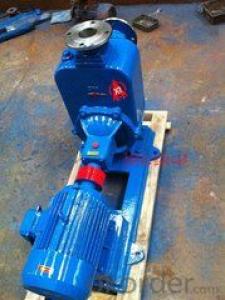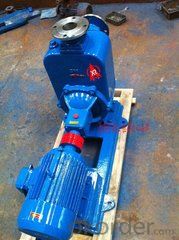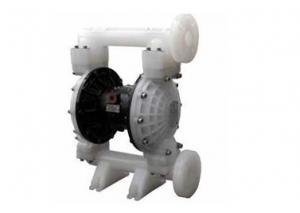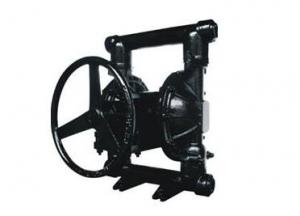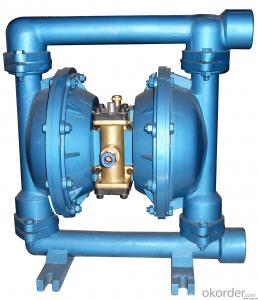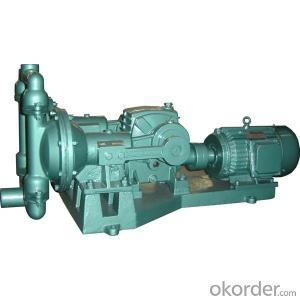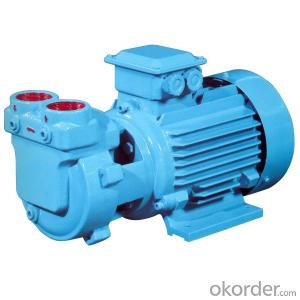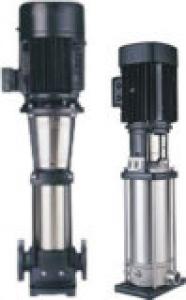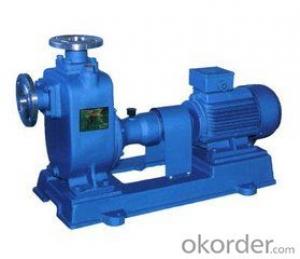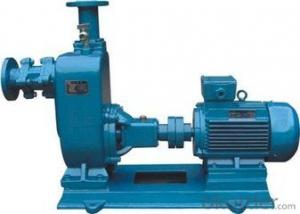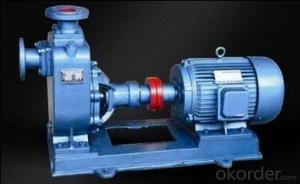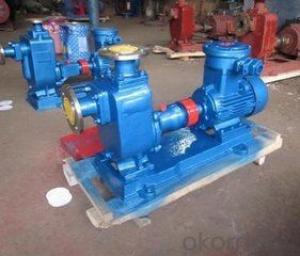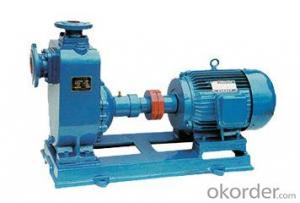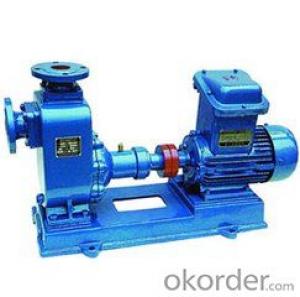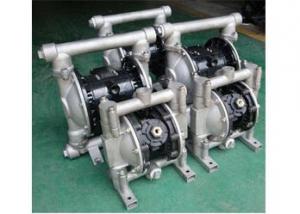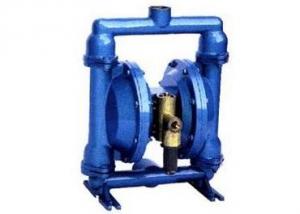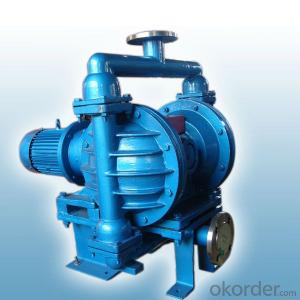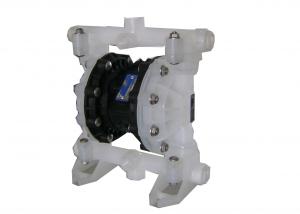ZX series self-priming pump 50ZX-12.5-50
- Loading Port:
- Shanghai
- Payment Terms:
- TT OR LC
- Min Order Qty:
- 10 unit
- Supply Capability:
- 300 unit/month
OKorder Service Pledge
OKorder Financial Service
You Might Also Like
A, product overview
This company produces the ZX series self-priming pump is the earliest according to relevant technical data at home and abroad after absorption, digestion, improve the development of pump energy saving products.Self-priming centrifugal pump, the pump and other pump does not have the self-priming capacity, etc.Such as corrosion resistant mechanical seals and stainless steel material can call some of the chemical, pharmaceutical acid and alkali medium.
Second, the product features
1, the pump with self-priming function, do not need to install the bottom valve in pipeline, only to ensure storage in pump body before work are quantitative liquid can have "a drainage, life-long self-priming" function.So both simplifies the pipeline system, and improved the working conditions.
2, has a compact structure, convenient operation, stable operation, easy maintenance, high efficiency, long service life.
Three, use the product
1) suitable for urban environmental protection, construction, fire control, chemical, pharmaceutical, dyes, and dyeing, brewing, electric power, electroplating, papermaking, oil, mining, equipment cooling, tanker unloading, etc.
(2) apply Yu Qingshui, sea water, chemical liquid medium with acid, alkalinity and with general mushy slurry (medium viscosity 100 mile, or less under the solid content of 30%).
(3) mount a rocker arm sprayer, the water can go into the air, a small drips to spray, is a good tool for farm, nursery, garden, tea garden.
And (4) can be matched with pressure filter of any model and specifications, sending size belt filter to filter the most ideal auxiliary pump.
Fourth, working conditions
Traffic: 3 ~ 500 m3 / h
Head: 10 ~ 80 m
Ambient temperature 50 ℃ or less
Medium temperature is 100 ℃ or less
Medium density of 1.24 or less by 103 kg/m3
- Q: Are air pumps powered by electricity?
- Yes, air pumps are typically powered by electricity.
- Q: Can an air pump be used for inflatable water fountains?
- Indeed, inflatable water fountains can indeed utilize an air pump. The inflation and maintenance of their shape typically necessitate the presence of air. To achieve this objective, employing an air pump proves to be both expedient and effective. Simply by linking the air pump to the inflatable water fountain, the latter can be effortlessly inflated and made ready for utilization within a few minutes. It is crucial to bear in mind, however, that the precise type of air pump required may differ contingent upon the size and configuration of the inflatable water fountain. It is advisable to peruse the manufacturer's instructions or consult a professional to ensure the appropriate air pump is employed for the particular model of fountain.
- Q: How to calculate the required air flow rate for a specific application?
- In order to calculate the necessary air flow rate for a particular application, several factors must be taken into account. First and foremost, the volume of air required for the application needs to be determined. This can be achieved by assessing the size of the space or equipment that requires air supply. For instance, if the air flow rate for a room's ventilation system is being calculated, the dimensions of the room (length, width, and height) need to be measured and multiplied to determine the volume. Subsequently, the air change rate necessary for the application must be considered. This refers to the frequency at which the air in the space needs to be replaced within a specific time period. Different applications have varying requirements for air change rates, which depend on factors such as occupancy levels, industry standards, and air quality needs. For example, a laboratory may require more frequent air changes compared to an office space. Once the volume of air and the required air change rate have been determined, these values can be multiplied together to calculate the necessary air flow rate. This will provide the amount of air that needs to be supplied or circulated within the specified time frame. It is important to note that additional factors like air quality requirements, temperature control, and pressure differentials may need to be taken into consideration based on the specific application. Seeking advice from a professional in the field, such as an HVAC engineer, can ensure accurate calculations and proper system design for optimal performance.
- Q: How does an air pump help in maintaining water clarity in ponds?
- An air pump plays a crucial role in maintaining water clarity in ponds by promoting healthy oxygen levels in the water. The pump introduces air into the pond, which helps in breaking down organic matter, preventing the buildup of harmful gases, and promoting the growth of beneficial bacteria. One of the main benefits of an air pump is that it increases oxygen levels in the water. Adequate oxygen is essential for the survival of aquatic organisms and the overall health of the pond ecosystem. By constantly introducing air into the water, the air pump ensures that the oxygen levels remain high, preventing the occurrence of oxygen depletion, which can lead to fish stress, algae growth, and other water quality issues. Furthermore, an air pump helps in breaking down organic matter in the pond. Dead plants, decaying leaves, fish waste, and other organic debris can accumulate in the water, releasing harmful gases such as ammonia and hydrogen sulfide. These gases can be toxic to aquatic life and contribute to poor water quality. The air pump helps in aerating the water, enhancing the natural breakdown of these organic materials and preventing the release of harmful gases. In addition, the air pump promotes the growth of beneficial bacteria. These bacteria play a vital role in maintaining water clarity by breaking down excess nutrients such as nitrate and phosphate, which can fuel the growth of algae and lead to murky water. By introducing oxygen into the water, the air pump creates an ideal environment for these bacteria to thrive and efficiently carry out their natural processes of nutrient cycling, resulting in improved water clarity. In summary, an air pump is a valuable tool for maintaining water clarity in ponds. By increasing oxygen levels, breaking down organic matter, and promoting the growth of beneficial bacteria, the air pump helps to prevent the buildup of harmful gases, reduce algae growth, and improve overall water quality in the pond.
- Q: Can an air pump be used for reducing moisture in a space?
- No, an air pump cannot be used for reducing moisture in a space. An air pump is typically used for increasing air pressure or circulating air, but it does not have the capability to remove or reduce moisture. Dehumidifiers or moisture absorbers would be more suitable for reducing moisture in a space.
- Q: How to clean an air pump for optimal performance?
- To clean an air pump for optimal performance, follow these steps: 1. Unplug the air pump: Before starting the cleaning process, make sure the air pump is unplugged from the power source to avoid any accidents. 2. Disassemble the air pump: Carefully dismantle the air pump, following the manufacturer's instructions. Usually, you will need to remove the outer casing and detach any filters or other removable parts. 3. Remove any debris: Check the air pump for any dirt, dust, or debris that may have accumulated. Use a soft brush, cloth, or compressed air to gently remove any particles from the pump's components. Pay special attention to the intake and output valves, as any blockages in these areas can affect the pump's performance. 4. Clean the filters: If your air pump has filters, remove them and clean them separately. Rinse the filters under running water or soak them in a mild detergent solution to remove any dirt or residue. Allow them to dry completely before reassembling the pump. 5. Inspect the tubing: Check the air tubing for any signs of damage or clogs. If there are any blockages, carefully remove them using a pipe cleaner or similar tool. Replace any damaged tubing to ensure optimal airflow. 6. Clean the impeller: The impeller is a crucial component responsible for generating air flow. Gently remove the impeller from the pump and clean it with a soft brush or cloth. Make sure there are no obstructions or buildup on the impeller blades. If necessary, soak the impeller in a vinegar or citric acid solution to dissolve any mineral deposits. Rinse it thoroughly and dry it before reassembling the pump. 7. Reassemble the pump: Once all the components are clean and dry, carefully put the air pump back together following the manufacturer's instructions. Ensure that all the connections are secure and tight. 8. Test the pump: Plug the air pump back into the power source and test it to ensure it's working properly. Check for any unusual noises, vibrations, or reduced airflow. If any issues persist, refer to the manufacturer's troubleshooting guide or contact customer support for further assistance. Regular maintenance and cleaning of your air pump will help keep it running smoothly and maintain optimal performance. It is recommended to clean your air pump every few months or as specified by the manufacturer to prevent any potential problems and extend its lifespan.
- Q: What is the noise level produced by an air pump during operation?
- The noise level that an air pump produces while in operation can vary depending on several factors. These factors include the type and quality of the air pump, the speed at which it operates, and the surrounding environment. Typically, air pumps generate a moderate level of noise, ranging from 40 to 70 decibels (dB). Smaller and more efficient air pumps tend to create less noise, whereas larger and more powerful ones may produce higher levels of noise. Additionally, the speed at which the air pump operates can impact the noise level, with higher speeds generally resulting in louder noise. It is worth noting that the noise level of an air pump can also be influenced by the environment in which it is used. If the air pump is placed in a closed or small space, the noise can be amplified due to the reverberation effect. Conversely, if the air pump is utilized in an open or well-ventilated area, the noise may be less noticeable. To minimize noise, there are certain measures that can be implemented. The use of an air pump with noise-reducing features, such as rubber feet or vibration dampening materials, can help decrease noise levels. Additionally, placing the air pump on a stable surface or utilizing soundproofing materials in the surrounding area can also reduce noise. In conclusion, although air pumps do generate some level of noise during operation, it is generally manageable and can be mitigated through the use of appropriate equipment and placement.
- Q: Are there air pumps that can be operated with voice commands?
- Yes, there are air pumps available that can be operated with voice commands. These air pumps are equipped with voice recognition technology, allowing users to control and operate them simply by speaking out commands. By using voice commands, users can start or stop the air pump, adjust the pressure, or even set specific inflation levels without physically pressing any buttons. This hands-free operation makes it convenient and easy to use, especially in situations where manual operation may be difficult or inconvenient. Additionally, voice command air pumps often come with other features such as built-in pressure sensors, digital displays, and automatic shut-off, ensuring precise and efficient inflation.
- Q: Are air pumps suitable for aerating ponds?
- Indeed, ponds can benefit greatly from the use of air pumps for aeration purposes. It is a common practice to incorporate air pumps within pond aeration systems in order to enhance the oxygen levels in the water. By infusing the pond with air, the air pump facilitates the circulation and oxygenation of the water, which is crucial for the well-being of fish and other aquatic organisms. Furthermore, it serves as a preventative measure against the accumulation of detrimental gases and toxins in the water. Moreover, air pumps are capable of managing the growth of algae and improving the clarity of the water. Therefore, it is strongly advised to employ air pumps in order to aerate ponds and maintain a thriving aquatic environment.
- Q: Can an air pump be used for inflatable water slides for home use?
- Yes, an air pump can be used for inflatable water slides for home use. In fact, an air pump is typically necessary to inflate and maintain the air pressure of the slide. The size and type of air pump needed may vary depending on the size and design of the water slide. It is important to ensure that the air pump has enough power and airflow capacity to properly inflate the slide. Additionally, it is crucial to follow the manufacturer's instructions and safety guidelines for proper use and maintenance of the water slide and air pump to ensure a safe and enjoyable experience.
Send your message to us
ZX series self-priming pump 50ZX-12.5-50
- Loading Port:
- Shanghai
- Payment Terms:
- TT OR LC
- Min Order Qty:
- 10 unit
- Supply Capability:
- 300 unit/month
OKorder Service Pledge
OKorder Financial Service
Similar products
Hot products
Hot Searches
